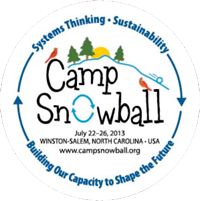Camp Snowball immerses adults and children alike in the valuable tools of systems thinking and sustainability education.
 Here at the Donella Meadows Institute, thinking systemically is one of the pillars of our work. Systems thinking helps us to identify problems, develop solutions, and build a tight, highly functioning team. It’s a skill that’s useful in a variety of situations, especially in today’s complex and changing world. And it’s a skill that can be learned.
Here at the Donella Meadows Institute, thinking systemically is one of the pillars of our work. Systems thinking helps us to identify problems, develop solutions, and build a tight, highly functioning team. It’s a skill that’s useful in a variety of situations, especially in today’s complex and changing world. And it’s a skill that can be learned.
Recently, we were excited to hear about Camp Snowball from our friends at the Academy for Systemic Change. This one-week immersion experience teaches and coaches participants in the tools of systems thinking and sustainability. It’s designed for educators, students, parents, and community members to take part, often together as teams. For those interested in bringing systems thinking and sustainability into education, Camp Snowball is a leading and visionary opportunity.
During the program, participants are introduced to core systems thinking tools and are engaged in learning journeys to experience “systems-in-action.” The video below shows one activity in which students used the example of a watering hole to understand stock-and-flow dynamics. Stocks and flows are the basic building blocks of many more complex systems, from natural resources to banking. As Donella Meadows herself wrote, as you learn to use this sort of systems tool, “you begin to see how simple stocks and flows, plumbed together, make up systems way too complex to figure out.”
To learn more about Camp Snowball, its programs, and its exceptional staff, visit the Camp Snowball website. Registration is currently open if you are interested in participating. Camp Snowball also offers a partner camp, Camp Sunshine. This camp is specifically designed to engage younger students in grades K-5 in systems thinking experiences.
Did the above video got you interested in stocks and flows and other systems tools? If so, we recommend reading the first few pages of Donella Meadows’s Leverage Points article for an easy-to-understand explanation. Once you’ve completed that, try reading this chapter of Thinking in Systems for a more in-depth explanation. Welcome to systems thinking!







